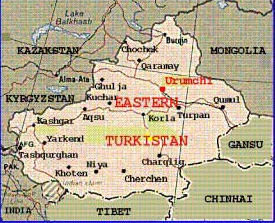
Uyghur
Uyghur ( Уйғурчә, ئۇيغۇر تىلى, Uyƣur tili, Уйғур тили), also known as Uighur, Uygur, Uigur, Weiwuer, is a member of the Turkic branch of the Altaic language family. It is spoken by 10.1 million people in Xinjiang Uyghur Autonomous Region in northwest China, also known as Chinese Turkestan, Eastern Turkistan, or Uyghuristan. It is also spoken by some 300,000 people in Kazakhstan. In addition, there are Uyghur-speaking communities in most countries of Central Asia, as well as in the United States and United Kingdom. The total population of Uyghur speakers around the world is estimated at 10.4 million people (Ethnologue).
In ancient times, the Uyghurs lived in an area of present-day Mongolia, where they had established a state which existed until 840 AD when it was defeated by Kyrgyz invaders. After their defeat, some Uyghurs moved to Ordos in northern China. They are believed to be the ancestors of Yugur, or Yellow Uyghurs, whose language is different from Uyghur. A much larger group of Uyghurs moved to Turfan in northeastern China, where they established another state which endured until the 15th century. These people spoke what is now the Turfan 
Following the establishment of the Central Asian kingdom, the Chagatai Khanate, the term Uyghur gradually disappeared. The official language was Chagatai, an artificial literary language based on Uyghur and Uzbek. The term Uyghur reappeared in 1921 when it was officially re-eastablished as the name of the Uyghur people.
Standard Modern Uyghur differs from the Uyghur spoken before the establishment of the Chagatai Khanate. In the 19th century, large numbers of Uyghurs from different parts of Eastern Turkestan settled in areas along the Ili River. Their dialect arose from a mixture of the varieties spoken by the new settlers and the local Ili variety that played a dominant role in the formation of modern standard Uyghur.
Status
- China
The Uyghurs are one of the 56 officially recognized nationalities in China, and Uyghur is the official regional language of the Xinjiang Uyghur Autonomous Region. It is widely used in all domains, including education and print and electronic media with over 50 newspapers and magazines, and half-a-dozen TV channels. Education in Uyghur is available from the secondary to the university level (the latter requires proficiency in Chinese as well). Monolingual speakers are found mostly among the older population while most young people and educated Uyghurs speak Chinese. - Kazakhstan
Over 80% speak of Uyghur speakers in Kazakhstan speak Uyghur as their first language. Most young people and educated Uyghurs also speak Russian.
Dialects
Ethnologue identifies a number of varieties of Uyghur that are further broken down into subdialects.
- Akto Turkmen
- Central Uyghur (the basis of Standard Uyghur)
- Dolan
- Lopnur
- Southern Uyghur
Structure
Sound system
Vowels
Uyghur has 7-9 vowel phonemes, depending on the dialect. They can be either short or long. Vowel length makes a difference in word meaning.
Like most Turkic languages, Uyghur is characterized by vowel harmony, a type of phonological process that involves constraints on what vowels may be found near each other. There are two kinds of vowels — front vowels, which are produced at the front of the mouth, e.g., /i/, /e/, and back vowels, produced at the back of the mouth, e.g., /a/, /u/, /o/. Native Uyghur words can contain only all front or all back vowels, and all suffixes must conform to the vowel of the syllable preceding them in the word.
The table below shows the vowels of Uyghur.
| Central | ||||
|---|---|---|---|---|
|
Unrounded
|
Rounded
|
|||
| Close |
i
|
y
|
ɨ
|
u
|
| Close-mid |
e
|
ø
|
o
|
|
| Near-open |
æ
|
|||
| Open |
a
|
|||
- /y/ = second vowel in statue
- /ø/ has no equivalent in English
- /æ/ = a in cat
- /ɨ/ similar to e in roses
Consonants
Uyghur has 25 consonant phonemes, i.e., sounds that distinguish word meaning.
| Bilabial | Labio-dental | Dental/Alveolar | Post-alveolar | Palatal | Velar | Glottal | ||
|---|---|---|---|---|---|---|---|---|
| Stops | voiceless |
p
|
t
|
k
|
||||
| voiced |
b
|
d
|
g
|
|||||
| Fricatives | voiceless |
f
|
s
|
ʃ
|
x
|
h
|
||
| voiced |
v
|
z
|
ʒ
|
ɣ
|
||||
| Affricates | voiceless |
tʃ
|
||||||
| voiced |
dʒ
|
|||||||
| Nasals |
m
|
n
|
ŋ
|
|||||
| Tap (flap) |
r
|
|||||||
| Lateral |
l
|
|||||||
| Approximant |
w
|
j
|
- /ʔ/ = sound between the vowels in uh-oh
- /x, ɣ/ have no equivalents in English
- /ʃ/ = sh in shop
- /ʒ/ = s in vision
- /tʃ/ = ch in chop
- /dʒ/ = j in job
- /ŋ/ = ng in song
- /j/ = y in yet
Stress
Uyghur words are normally stressed on the final syllable.
Grammar
Like all Turkic languages, Uyghur is agglutinative, i.e., suffixes are added to stems to form new words and to indicate grammatical relations. In agglutinative languages, affixes do not become fused with each other and do not change their form. They are strung together one after another, resulting on occasion in long words .Like all agglutinative languages, Uyghur uses postpositions rather than prepositions.
Nouns and adjectives
Uyghur nouns are marked for the following categories:
- There are two numbers: singular and plural.
- There are six cases: nominative, genitive, dative, accusative, locative, ablative. Cases are marked by inflectional suffixes whose forms depend on whether the stem ends in a front vowel, a back vowel, a voiced consonant, or a voiceless consonant.
- There is no definite article.
- There is no grammatical gender.
- Possession is represented by the suffix –m, e.g. aka ‘elder brother’, aka-m ‘my elder brother.’
- Adjectives have four degrees of comparison:
-
- positive
- comparative
- weakened, similar to the meaning of –ish in longish
- superlative which can be expressed in several ways, including reduplication, e.g., uzun-uzun ‘very long’.
Verbs
Uyghur verbs agree with their subjects in person and number. Verbs have the following grammatical categories:
- two numbers: singular and plural;
- three persons: 1st, 2, 3rd;
- five moods: indicative, dubitative, imperative, conditional, subjunctive;
- two voices: active and passive with different forms for passive transitive and passive intransitive verbs;
- three tenses: present, past, future;
- evidentiality that is required at all times and which indicates whether evidence exists for a given statement. Uyghur contrasts direct information (reported directly) and indirect information (reported indirectly).
- politeness (respect)
- there are fairly complex rules for interrogative and negative forms
Word order
The normal word in Uyghur is order is Subject-Object-Verb, but other word orders can be used to mark topic and comment in the discourse. Adjectives precede the nouns they modify.
Vocabulary
Uyghur vocabulary is basically Turkic with a large number of loanwords from Russian, Mongolian, Chinese, Arabic, Persian, and Sanskrit, e.g., bilet ‘ticket’ from Russian bilet; qje ‘chicken’ from Chinese ji.
Below are a few common words and phrases in Uyghur.
| Hello | Yahximusiz |
| Thank you | Rehmet |
| Please | Merhemet |
| OK | Bolidu |
| Excuse me | Kequrung |
| Yes | He’e |
| No | Yakh |
| Man | Adem |
| Woman | Hotun |
Below are Uyghur numerals 1-10.
|
1
|
2
|
3
|
4
|
5
|
6
|
7
|
8
|
9
|
10
|
|---|---|---|---|---|---|---|---|---|---|
|
bir
|
ikki
|
üq
|
töt
|
bex
|
alte
|
yet’te
|
sekkiz
|
tokh’khuz
|
on
|
Writing
Over the course of its history, Uyghur was written with several scripts.
- Between the 8th and the 16th century, Uyghur was written with an alphabet known as Old Uyghur which was based on old Sogdian which itself was derived from the Syriac script. The Old Uyghur alphabet was written from left to right in vertical columns. Letters had three different shapes, depending on their position in a word: initial, medial, or final.
- From the the 16th century until the early 20th century, Uyghur was written with the Chagatai version of the Arabic alphabet.
- During the 20th century, Uyghur was written with several versions of the Latin and Cyrillic alphabets adapted to represent the sounds of Uyghur.
- In 1987, Arabic script replaced the Latin alphabet as the official script for writing Uyghur in China. In this version, all vowels are spelled out.
| Modified Cyrillic-based alphabet for Uyghur (уйғур елипбәси) used by Uyghurs in the former Soviet Republics of Central Asia. | |||||||||||||
|---|---|---|---|---|---|---|---|---|---|---|---|---|---|
|
А а
|
Б б
|
В в
|
Г г
|
Ғ ғ
|
Д д
|
E e
|
Ë ë
|
Ә ә
|
Ж ж
|
Җ җ
|
З з
|
И и
|
Й й
|
|
К к
|
Қ қ
|
Л л
|
М м
|
Н н
|
Ӊ ӊ
|
О о
|
Ө ө
|
П п
|
Р р
|
С с
|
Т т
|
У у
|
Y y
|
|
Ф ф
|
Х х
|
Һ һ
|
Ч ч
|
Ш ш
|
Ы ы
|
Э э
|
Ю ю
|
Я я
|
|||||
| Modified Latin-based alphabet for Uyghur used by Uyghurs in Xinjiang province of China for 15–20 years until late 1980s. It is still used for Internet communications in Uyghur. | ||||||||||||||
|---|---|---|---|---|---|---|---|---|---|---|---|---|---|---|
|
А а
|
B b
|
Ch ch
|
D d
|
É é
|
F f
|
G g
|
Gh gh
|
H h
|
I i
|
J j
|
K k
|
L l
|
M m
|
N n
|
|
Ng ng
|
O o
|
Ö ö
|
P p
|
Q q
|
R r
|
S s
|
Sh sh
|
T t
|
U u
|
Ü ü
|
W w
|
X x
|
Y y
|
Z z
|
Take a look at Article 1 of the Universal Declaration of Human Rights in Uyghur.
| Arabic ھەممە ئادەم زاتىدىنلا ئەركىن، ئىززەت-ھۆرمەت ۋە ھوقۇقتا بابباراۋەر بولۇپ تۇغۇلغان. ئۇلار ئەقىلغە ۋە ۋىجدانغا ئىگە ھەمدە بىر-بىرىگە قېرىنداشلىق مۇناسىۋىتىگە خاس روھ بىلەن مۇئامىلە قىلىشى كېرەك |
| Cyrillic Һәммә адәм занидинла әркин, иззәт-һөрмәт вә һоқуқта баббаравәр болуп туғулған. Улар әқилғә вә виджданға игә һәмдә бир-биригә қериндашлиқ мунасивитигә хаш рох билән му’амилә қилиши керәк. |
| Latin Hemme adem zanidinla erkin, izzet-hörmet we hoquqta bapbarawer bolup tughulghan. Ular eqilge we wijdan’gha ige hemde bir-birige qérindashliq munasiwitige xas roh bilen muamile qilishi kérek. |
| All human beings are born free and equal in dignity and rights. They are endowed with reason and conscience and should act towards one another in a spirit of brotherhood. |
Difficulty

There is no data on the difficulty of Uyghur for speakers of English.